Natural pearls have always held a timeless allure due to their innate brilliance and unique iridescence.
Their captivating charm and intricate coloration make them highly prized by jewel collectors worldwide.
This fascination with natural pearls has led to the creation of some of the most expensive pieces in history.
1. Marie Antoinette’s Natural Pearl and Diamond Pendant, Last Sold at Auction $36.8 Million, November 2018, Sotheby’s
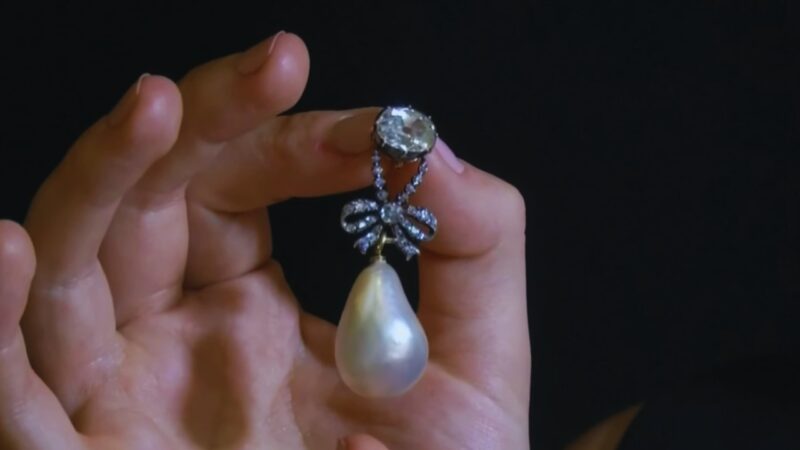
Marie Antoinette, the ill-fated Queen of France, possessed an opulent jewelry collection worth millions during her reign. After her attempt to flee Versailles amid the French Revolution, much of her collection was covertly transported out of the country. These precious items were sent to Belgium, and then to Vienna, under the watchful eye of the imperial ambassador to France, the Comte de Mercy Argenteau.
Marie Antoinette took special measures to ensure the safety of her jewels. She directed the Comte to deliver them to her sister, Archduchess Marie Christine, the governor of Brussels. The jewels were subsequently safeguarded by her cousin, Emperor Franz II of Vienna.
Captured and imprisoned before their escape could be completed, both Marie Antoinette and her family were eventually executed, leaving only her daughter, Marie Thérèse de France, later known as Madame Royale, alive. Exiled to Vienna, she inherited her mother’s remarkable collection, which has since been preserved by the Bourbon Parma family for nearly two centuries.
Among these extraordinary pieces is a natural pearl and diamond pendant that made history at Sotheby’s auction in November 2018. This pendant features a semi-baroque drop-shaped pearl measuring 15.90 x 18.35 x 25.85mm, elegantly suspended from a hinged-closure bale adorned with a bow motif. A prominent oval diamond is set at the center of the bow, enhancing the overall elegance of the piece.
Initially, the pendant was expected to fetch between $1 million and $1.9 million. The item’s storied provenance, however, ignited significant interest, causing its value to skyrocket. It ultimately shattered previous records for natural pearls at auction, selling for an astonishing $36.8 million, making it the most expensive natural pearl ever sold.
The sale at Sotheby’s was a landmark event, highlighting the enduring allure and historical significance of Marie Antoinette’s jewelry. The combination of exquisite craftsmanship, imperial heritage, and dramatic historical context contributed to the pendant’s unprecedented auction success. Standing as a testament to a bygone era, this pendant continues to captivate collectors and historians alike.
2. Marie Antoinette’s Three-Strand Natural Pearl and Diamond Necklace, $2.2 million, Sold November 2018 Sotheby’s

The Three-Strand Natural Pearl and Diamond Necklace, once owned by Marie Antoinette, was highlighted in the historic auction at Sotheby’s. This necklace, among the jewels discreetly taken from France during the revolution, comprises slightly graduated strands with 119 off-round to button-shaped natural pearls.
These pearls range from approximately 7.30mm to 9.30mm in size. The piece is completed with a circular diamond clasp adorned in a star motif and decorated with round, cushion, and rose-cut diamond accents.
The necklace achieved a sale price of $2.2 million at the auction. Despite this, it remains a significant historical artifact. It is frequently mentioned in Marie Antoinette’s jewelry inventories and is known to have been a gift from her mother, Empress Marie Therese.
The original form of the necklace was a long triple strand featuring 160 pearls, later restyled into a single long sautoir. As styles evolved, the necklace was reconfigured to its current three-strand layout containing 119 pearls, with the remaining pearls forming a separate single-strand necklace of comparable size.
3. La Peregrina, “The Wanderer”, Last Sold at Auction $11.8 Million December 2011, Christie’s Auction House
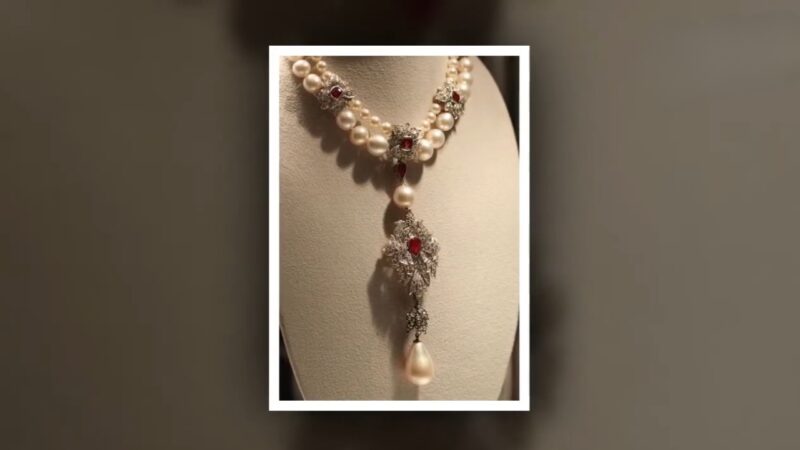
La Peregrina, known as “The Wanderer” or “The Pilgrim,” is perhaps the world’s most famous pearl. This remarkable drop-shaped natural pearl was initially discovered by an African slave in the Gulf of Panama. The pearl was then taken back to Spain and given to King Philip II as part of the Spanish Crown Jewels, where it stayed for 250 years.
The pearl’s journey continued when it came under the possession of the Bonaparte family in 1808 during Joseph Bonaparte’s occupation of the Spanish throne. He fled with La Peregrina in 1811 but eventually passed it on to the Duke of Abercorn in England. For nearly a century, it remained with the Abercorn family until it was auctioned.
In 1969, actor Richard Burton bought La Peregrina for his wife, Elizabeth Taylor, as a Valentine’s Day gift for just $37,000. Taylor cherished the pearl, wearing it frequently and eventually commissioning Cartier to design an elaborate necklace featuring the gem. The necklace, a blend of pearls, diamonds, and rubies, showcased La Peregrina prominently.
4. The Seven-Strand “Festoon” Natural Pearl Necklace, Last Sold for $9.08 Million, November 2013, Christie’s Auction House

This exquisite seven-strand “Festoon” necklace comprises 614 pearls that transition in size from 5.1 mm to 17.05 mm. The pearls display a variety of off-round-to-button shapes and boast stunning cream-to-rose overtones. Measuring 35 inches in length, the necklace is completed with a clasp crafted from a combination of platinum and white gold, adorned with Cushion and Old-Mine Cut diamonds.
Reportedly, the original owner of this magnificent necklace was a royal family, though Christie’s has kept their identity confidential. The Swiss Gemological Institute confirmed the extraordinary quality and matching of the natural saltwater pearls, a remarkable feat rarely seen in such pieces.
A notable appendix letter accompanying the gemological report, titled “Exceptional Natural Pearl Necklace,” highlights the unique characteristics of the pearls. The document describes the pearls as having a smooth surface with a fine, matching luster.
Their colors range subtly from white to cream, with distinct rose and green overtones. These overtones, sometimes referred to as the ‘Orient of the pearls,’ result from an iridescent effect on the pearl’s surface, significantly enhancing their beauty.
Ranked as the third most expensive pearl necklace globally, the seven-strand “Festoon” necklace initially had an estimated value of $3,000,000.00. However, its outstanding size, color, and exceptional natural pearl quality led to a final auction price of $9,081,662 at Christie’s Magnificent Jewels Auction in 2013, setting a record.
5. Emperor Yongzheng’s (Yinzhen) Ceremonial Eastern Pearl Court Necklace, Sold for $8.7 Million, Sotheby’s Hong Kong, April 2010

The intricate Ceremonial Pearl Necklace, known as Chaozhou, was worn by Emperor Yongzheng who ruled China from the Forbidden City. This necklace is an exquisite piece, often compared to a Buddhist rosary or prayer beads.
Crafted with precision, the design follows strict rules: the sequence must include 108 beads with a distinct bead called the fotou or Buddha’s head, situated between sequences of 27 beads. Additionally, there are three strands called jinian extending from either side and an ornamental strap at the back, finished with a green foutouta, or Buddha head stupa.
For the royal family, the use of pearls was of paramount importance, and protocols designated the inclusion of four large coral beads, lapis lazuli beads, and jinian made with turquoise. This particular Chaozhou stands out for its rarity and remarkable value, believed to have been crafted between 1722-1735 specifically for the Emperor.
The necklace is adorned with natural Freshwater pearls, also known as dontzhu, which were reserved exclusively for the royal family. Today, there are only five known examples of Chaozhou using Eastern Freshwater pearls in all of China.
What makes this necklace particularly extraordinary is the use of very fine, large pearls measuring 9.6-10.65mm. These pearls are perfectly matched and flawless, retaining their luster and Orient even after 300 years. This level of quality and longevity is exceedingly rare.
Alain Truong emphasized the significance of freshwater pearls to the Emperor, noting that Eastern pearls were harvested from the Yalu, Sungari, and Amur rivers in Manchuria. These pearls were treasured by the Manchu rulers for their connection to their homeland. Rules stipulated that only the emperor and his family members could wear these precious pearls, whether as a necklace or sewn into Imperial robes.
In April 2010, this Chaozhou was sold at Sotheby’s Hong Kong for a staggering $8.7 million, making it the fourth most expensive pearl necklace ever sold. The exceptional craftsmanship, historical significance, and rare use of natural Freshwater pearls contribute to its high value and esteemed status.
6. The Baroda Pearl Necklace, Sold $7.1 Million at Christie’s Auction House, April 2007
The Baroda Pearl Necklace, once part of an extraordinary seven-strand natural pearl necklace, was worn by the Maharajas of India. These natural saltwater pearls, likely sourced from the southern coasts of India, were known for their exceptional quality.
The double-stranded necklace sold at auction comprised 68 pearls, each measuring between 9.47mm and 16.04mm in size. Such sizes are remarkably rare for natural pearls. The necklace was completed with a bespoke foliate Cartier clasp set with an 8.57-carat Old Mine diamond and circular-cut accents, all mounted in platinum.
To complement the necklace, the sale included a pair of matching natural pearl and diamond earrings. These earrings measured 13.34mm – 15.08mm x 22.26mm and 14.40mm – 15.01mm x 21.05mm respectively, featuring button-shaped natural pearl surmounts. Also part of the sale was a natural pearl and diamond brooch and a natural pearl and diamond ring.
The portrait of the 12th Gaekwad Maharajah Sayaji Rao III showcased him wearing the full seven-strand pearl necklace. This image became iconic when it appeared in the “Book of the Pearl,” published in 1908 by Tiffany’s renowned gemologist George Frederick Kunz. Kunz described the Baroda jewelry collection as “among the greatest jeweled treasures of India.”
7. The Cowdray Black Natural Pearl Necklace, Sold $5.3 Million at Christie’s Auction House, October 2015, Sotheby’s Hong Kong
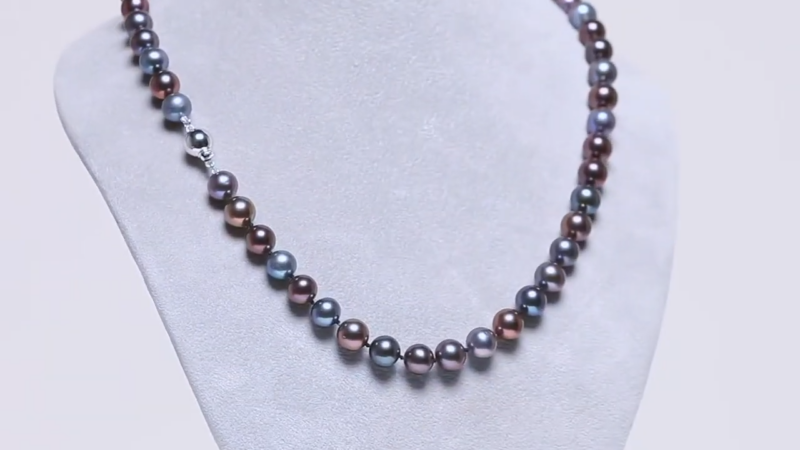
The Cowdray Black Natural Pearl Necklace is renowned as one of the world’s most celebrated and valuable natural black pearl necklaces. Initially owned by Lady Pearson, the Viscountess Cowdray, the exquisite piece consists of 38 natural Tahitian pearls.
These pearls feature a Medium Charcoal Grey body color complemented by a range of overtones including Peacock, Silver, Rose, Blue-Green, and Bronze. The necklace is completed with an elegant rectangular diamond clasp crafted by Cartier.
Originally, this strand held 42 pearls ranging in size from 6.8 to 11.4mm. After its first auction in 1937, a subsequent owner removed two pearls to create earrings. In 2012, the necklace was restored to its original count by adding exceptional Tahitian pearls that seamlessly matched the existing strand.
In 2007, the Cowdray Pearls fetched $3 million at Christie’s, but their value increased significantly in 2015 when they were auctioned at Sotheby’s Hong Kong. The necklace sold for a record-setting $5.3 million, making it the most expensive black pearl necklace globally and the sixth most expensive pearl necklace overall.
8. Unnamed Four-Strand Black Natural Pearl Necklace, Sold $5.1 Million at Christie’s Auction House
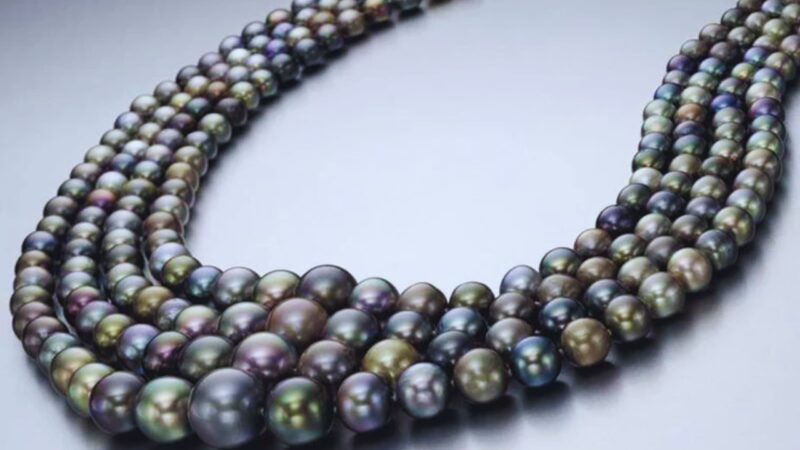
This exquisite Four-Strand Black Natural Saltwater Pearl Necklace made history in April 2015 at Christie’s Magnificent Jewels Auction. Each of the four strands glistens with 289 natural saltwater black pearls, known for their breathtaking range of colors including Peacock, Green, Blue-Green, Aubergine, Rose, Bronze, Pistachio, and Silver.
The origins of these pearls remain a mystery, as does the identity of the current owner. The pearls themselves range in size from 4.9mm to 12.65mm. To achieve a harmonious look, the strands are meticulously graduated with 63, 69, 76, and 81 pearls respectively, all expertly matched for size and shape.
The necklace is elegantly finished with a cushion-cut diamond weighing 3.03 carats. This central diamond is complemented by Old European cut diamond accents, all set in silver-topped white gold. Black natural saltwater pearls are among the rarest gemstones around the world, and this necklace showcases them in a stunning display of sophistication.
9. Single Strand White Natural Pearl Necklace Owned by the Duchess of Windsor, Last Sold $4.8 Million, Christie’s Auction House, December 2007

This natural pearl necklace boasts a grand origin dating back to Imperial Russia. Initially held by Dowager Empress Maria Feodorovna, it found its way to King George V of England in 1929. Subsequently, these exquisite pearls were gifted to Queen Mary of England and later inherited by her successor, Edward Duke of Windsor. In 1937, he gave the necklace to Bessie Wallis-Simpson upon their marriage.
Comprised of 28 natural pearls, the necklace showcases a creamy white hue. These pearls range in size from 9.2mm to a noteworthy 16.8mm, hinting at their likely Australian origin from the Pinctada maxima pearl oyster, known for its large, high-quality South Sea pearls. The pearls exhibit shapes such as Round, Oval, Drop, and Button, all symmetrically arranged.
Queen Mary had the necklace restrung with a custom diamond clasp by Cartier. This Cartier clasp features two Emerald-Cut diamonds totaling 2.00 carats, two Fancy-Cut Trapezoid diamonds adding another 2.00 carats, and is further adorned with 20 Single-Cut Round diamonds totaling 0.70 carats. The final length of the necklace is 14 inches, designed as a snug choker.
In 1950, the Duke of Windsor commissioned Cartier to complete a matching suite for his wife, adding a large, Drop-Shaped natural pearl pendant and round natural pearl earrings. Following the Duchess of Windsor’s death in 1986, the necklace and other jewels were auctioned to fund medical research in AIDS and cancer therapies. Sold by Sotheby’s in 1987, the necklace was bought by fashion designer Calvin Klein for $733,000.
Kelly Klein prized this piece, wearing it for two decades. In 2007, she decided to sell the necklace, which was added to Sotheby’s Magnificent Jewels Sale. The pearls were displayed globally in cities across Asia, Europe, the Middle East, and the U.S., highlighting their exceptional beauty and historical significance. The necklace eventually sold for $4.8 million in December 2007.
10. Pierre Cartier’s Double-Strand Natural Pearl Necklace, Sold $3.7 Million, Christie’s, October 2012
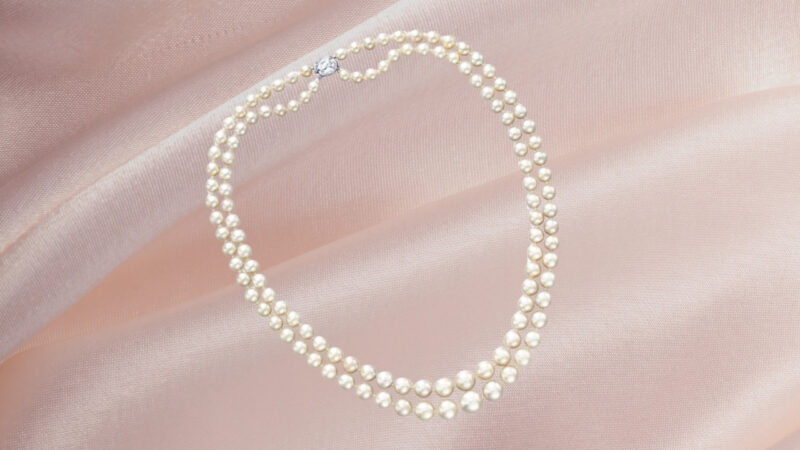
The name Cartier has long been associated with unparalleled luxury and exceptional jewelry design. By 1912, Pierre Cartier had solidified his reputation as a leading jeweler among New York’s elite. Despite his success, Cartier sought a grander location for his boutique, envisioning a space that would match the opulence of his collections.
The centerpiece of this story is a natural double-strand pearl necklace, completed with a diamond clasp designed by Cartier himself. The pearls, distinguished by their natural white hue and elegant gradation, captivated the eye of Maisie Caldwell Manwaring Plant, the wife of industrial magnate Morton Plant. Mae, enchanted by the necklace’s beauty, expressed a fervent desire to own it.
11. The Dodge Pearl Necklace, Three-Strand Natural Pearl Necklace, Last Sold $1.1 Million, Christie’s December 2018

The Dodge Pearl Necklace is a luxurious piece featuring three strands of natural pearls, each meticulously selected for its round shape and exceptional quality. These pearls range in size from 4.2mm to 10.25mm. The necklace is completed with an exquisite Art Deco diamond clasp created by Cartier around 1920.
This clasp features an Old Cushion Cut center diamond weighing 1.95 carats, flanked by two Swiss Cut diamonds totaling 1.75 carats. In addition, Round Brilliant Cut diamonds weighing 3.75 carats are mounted in platinum, adding to the overall elegance of the piece.
Reportedly originating in Imperial Russia, the pearls in this necklace are believed to have been owned by Russian Empress Catherine the Great. After the Russian Revolution, many of the Imperial jewels were sold or smuggled out of Russia. Pierre Cartier, an avid collector of pearls and Russian Imperial jewelry, purchased this necklace and later sold it to Horace Dodge, the founder of Dodge Motor Company.
Horace Dodge bought the necklace for his wife, Anna, whom he told could have anything she desired. Anna chose pearls. Interestingly, Anna wore the luxurious necklace publicly only twice before bequeathing it to her granddaughter, Yvonne Dodge.

